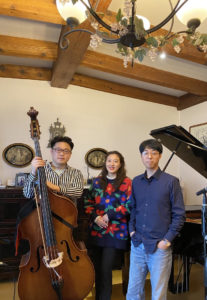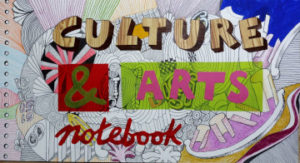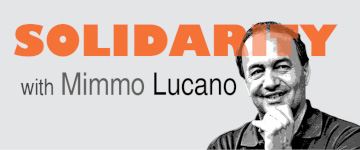MUSIC AND CULTURE/INTERVIEW
Pianist/composer Eunhye Jeong is a creative musician with a critical mind that keeps expanding her musical world with diligent research. She has performed with legendary Wadada Leo Smith, a multiple award-winner, a Pulitzer Prize nominee and an innovative composer/trumpeter as a pianist of NDA ensemble which performed one of ECM’s most celebrated albums, Divine Love, at the third CREATE Festival. She also performed as a duo with highly acclaimed cellist/improviser/composer Okkyung Lee and recorded with Pansori master Il-dong Bae. As a composer, she co-wrote the score for a short film “Ancestry” with Munyungo Jackson, Stevie Wonder’s percussionist. She also performed in renowned places such as the Museum of Fine Arts (Boston), UN Headquarters (NY), colleges such as Harvard University, Berklee College of Music, Boston College.

Seungha Lee (bass, left), Eunhye Jeong (piano, center), Sunki Kim (drums, right) at Advart Music, Seoul
She created an improvisation musical piece called Goindol Project, which literally means Dolmens, and performed live with her trio in Korean on Friday, April 8 2022 in Seoul. In her interview with Pressenza, she said that the concert went well. “We, the performers, were in the zone and the creative flow was there. We wanted to play more! That’s a good sign”.

Eunhye Jeong’s Chi-Da Quartet with Pansori singer Il-dong Bae
What was her motivation for doing the Goindol Project?
The stone [Dolmen] itself to me was adorable and seemed like a strong survivor of time. But it also signifies all the ruptured history and culture and, its effect on Koreans and our sense of Korean identity, she says. According to the Korean Cultural Heritage Administration website, dolmens ” “…are mostly found in Northeast Asia; they are particularly abundant in Korea where the total number of known dolmen is estimated to be around 30,000. In dolmen areas, many artefacts, including human bones, stone objects, jade, and bronze have also been discovered.” https://asiasociety.org/korea/unesco-world-heritage-series-part-1-dolmens Megalithic culture fully blossomed on the Korean peninsula in view of the degree of concentration and diversity in the forms and scales of dolmens discovered in the country. Dolmens are seen everywhere around Korea.

Example of a southern-style dolmen at Ganghwa Island. Wikimedia Commons.
Do you have any personal experience with the places, objects and items (Goindol) you depict in your musical project?
I recently saw one goindol in a park in Pohang-si when I visited my sister and her family at the end of 2021. What I saw looked nothing like the most known goindol type which is in the shape of “ㅠ”. It was just a huge stone. As I read the description, that goindol was moved from its place which was supposedly NOT even the original site. So it was moved and reinstalled twice or more. You know, when a plant becomes rootless and displaced from its own land, it loses its life-full energy, it withers and dies. That goindol felt like that a bit. That’s sad. Its very original site would have informed us about its history and more. The context is not just a background, I think, or I’d say the background is as equally important as the main figure or object, that deserves full attention to be studied. But now we don’t know where it was in what context anymore. We can only take a guess. For some people that mystery can be more fascinating to explore, which in part I resonate with. But what I really saw from this particular goingdol was this. The stone itself to me was adorable and seemed like a strong survivor of time. But it also signifies all the ruptured history, culture and its effect on Koreans and our sense of Korean identity. Then I remembered a chapter from a book I read as a teenager.
It’s called <하늘에 새긴 우리역사>. I can translate roughly as “Our History (we or the ancestors) Engraved in the Sky” It’s written by an astronomer, Chang-bum Park (박창범), a professor at SNU. I sold the copy I used to have about 15 years ago and I regretted that. Fortunately, when I came back to Korea last year, the same publisher was still printing the book and I was able to buy a copy of the 19th edition.
Before reading this book, I have never heard or learned that ancient Koreans and the ones who came after them were very keen astronomers! I didn’t really understand what it means to make calendars. Modern humans, me included, can become lazy when it comes to asking questions and finding answers the hard way. We have all the “answers” already and they are quite conveniently available. Our “time”, for instance, is standardized so we can just read numbers in our clock and calendars. I can truly understand now how important it would have been to observe the sky as to live and survive as residents of the Earth. Koreans have a long history of recording astronomical phenomena. The writer of the book found out that many of the astronomical records in the old history books are accurate, more than those of Chinese or Japanese books. Plus, as I wrote in the online program note about the project, goindols are not only tombs that required a large group of people for construction, but also the means to record some important astronomical knowledge. I am not either an astronomer nor an archaeologist. The experts, I hope, can conduct more scientific research on the subject to clarify it. But the fact is that the constellations are depicted directly onto the goindol with carved out holes and groups of goindols were arranged to depict the constellations, each goindol was sized differently according to the magnitude of stars.
And I heard about the so-called “Legoland” issue in Chuncheon. I didn’t include it as a part of the improvisational suite I initially set up. The reason is that I wanted to strengthen the historical and psychological meaning of Goindol before I address any current social issue. In the project, goindol really is a symbol of the long-forgotten history that no one knows. The concert at GhettoAlive in April 8th was another version, organically grown from the previous performance of the trio and had a new section for the issue. The entire concert was seamlessly performed with an intermission so it would not be obvious where it started to the audience. A motive I kind of assigned to the bass player signified that segment. So we the performers knew where it started.
You have said in your artist statement that “Ms. Jeong views Goindols as a gateway for the audience and the performers altogether to travel to the ancient time and perhaps to the universe that her ancestors observed and lived harmoniously with.” In this particular sense, what are you telling the world through your music?
I wrote very long passages about “what I am telling the world through the music of this project”. However, I could remark on the “travel to the ancient time and perhaps to the universe..” part. I often imagine a concert I perform in a spaceship traveling somewhere. If it is my project, I would be at the helm, operating that spaceship. The point is that performers and audience are all in the music-making together. I like to talk about “귀 명창” a lot. The direct translation of that is “ear master”. It means listeners can and must train themselves to be able to comprehend the mastery of music made by musicians. More importantly, it places listeners in an active position, who would also “perform” by actively engaging in listening in their own way. I wanted to invite everyone to what this entire project draws people to and what I thought was the ancient Koreans’ lives and the stars they saw. Somewhat like a time machine!
In your musical list there is a piece named, The 50,000th Goindol, why did you name it? Is there something related to this of your concern? “In addition to the suite, the trio will perform a segment to bring attention to the ongoing issue in Jung-do (or Jung Island), Chuncheon, where significant amounts of prehistoric to mid-bronze era artifacts were discovered. Although the study and preservation of these sites are crucial to understanding Korea’s ancient history, which is still a mystery in many ways, a theme park, Legoland, went ahead with its construction despite strong opposition from many citizens.”
Not particularly. I am sure at one point in history a group of people somewhere in Eurasia worked to build the 50,000th goindol. I wanted to meditate on that particular moment through music.
Please introduce us to Advart Music and its objectives, activities …
I don’t represent Advart Music and have very little knowledge of what it is and does. My trio was invited to perform in one of its house concert series which was video/audio-recorded in Advart Music in Hannam-dong. And there I was able to launch Goindol Project. I wanted to put it out for a long time with Sun Ki Kim and Seung-ha Lee, with whom I would love to keep working together in the future. As far as I know, it is basically a music production company. Oh, the director, although he doesn’t call himself that… and honestly I don’t know his title. He is the boss, that much is what I know… anyways, he translated several jazz theory books written in English and all of them were recently published in Korea. Kudos to him!

Goindol Project with Eunhye Jeong Trio at GhettoAlive, Seoul
I should add, though, GhettoAlive in Seongsu-Dong is an important place for creative, improvising musicians like myself. This venue is probably the only place in South Korea, that supports and promotes experimental, creative music. There is one more venue that is only recently open called “Gravitational Field” (I absolutely love the name). I will be performing a concert with a Dae-geum (traditional flute) player Jiyun Song, in May. They have a grand piano that I can really really play. I mean inside and outside. It’s so hard to find people who make and listen to creative music and venues that allow me to touch the inside of the piano in Korea. For many people, even for jazz musicians, free improvisation is some sort of a subgenre they might and might not touch on. So having those two places (GhettoAlive and Gravitational Field) plus Advart Music is such a blessing to me.

Do you remember when your first public performance was? How long have you been in the making of composing music?
I do. That is when I was 8 or 9 years old. I won a piano competition, first place in my age group or something. That competition committee took me, and some other winners, to a music school in Taipei, Taiwan to perform. I’ve never been to such a huge music school that housed students all the way from elementary to high school if I remember correctly. It was an epic experience. It was also the first time I traveled outside of my country.
As for composing music, when I was about 19, I attempted writing a piece inspired by Yann Tiersen, who wrote many good film scores. I watched a French movie called Amelie. I don’t remember the story very well now but I do remember I really loved the aesthetic quality, the character depiction, acting and many other aspects of the film. Music included! I was just so drawn to the “mise-en-scène” of it. And I realized that Tiersen’s compositional approach was sort of Neo-classical. Now I know I can say it’s “Neo-classical”, but what I really heard was simple triad chords accompanying simple melodies in a nicely spiced up way. I knew all the chords and knew how to create melodies that sound good within the progressions. So there I had my first composition. I have not recorded it though. Maybe the handwritten manuscript still exists but I do know there is a picture of me composing it. It must be somewhere in my parent’s home.
For further information and contact please visit her website: https://eunhyejeong.com/goindol












